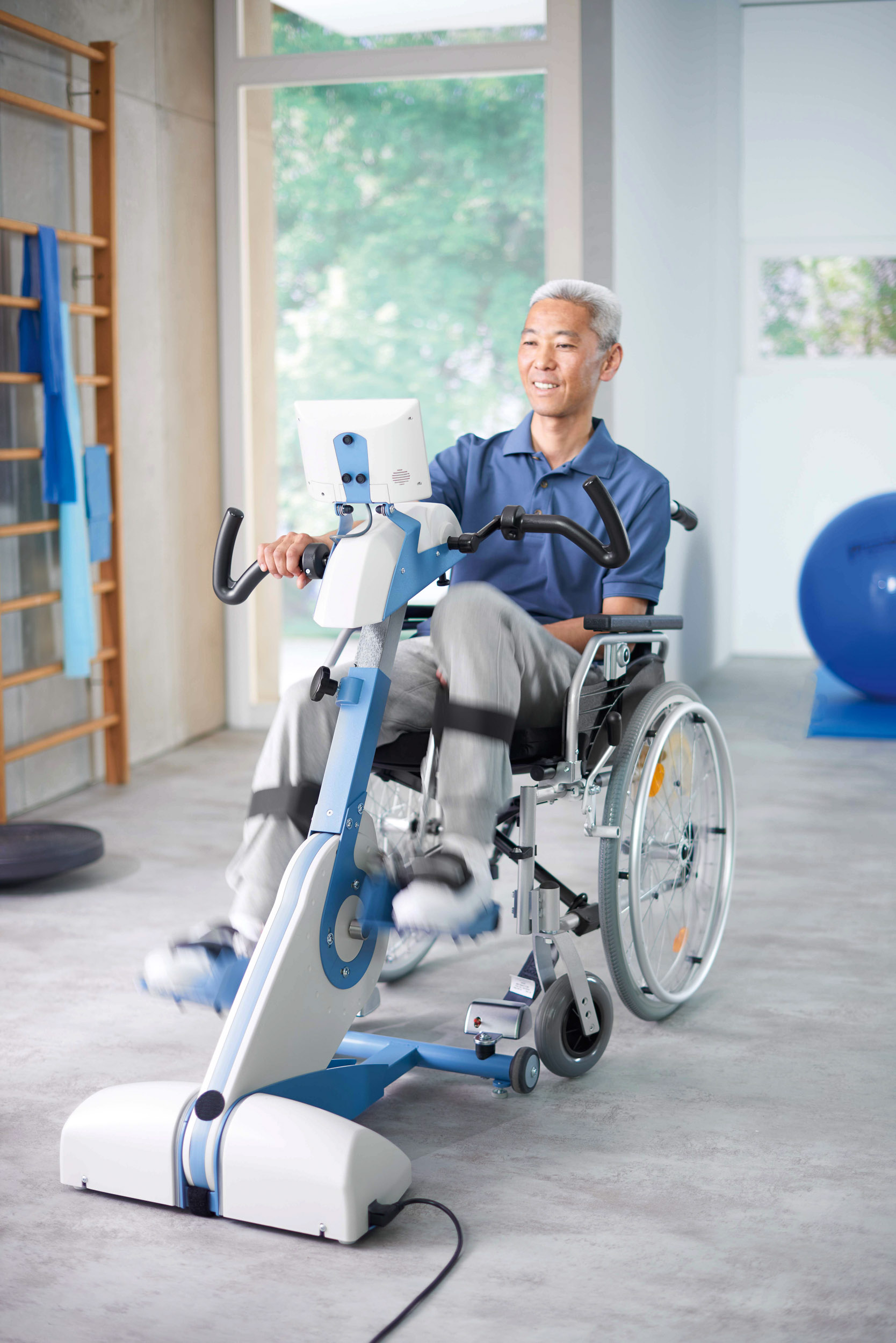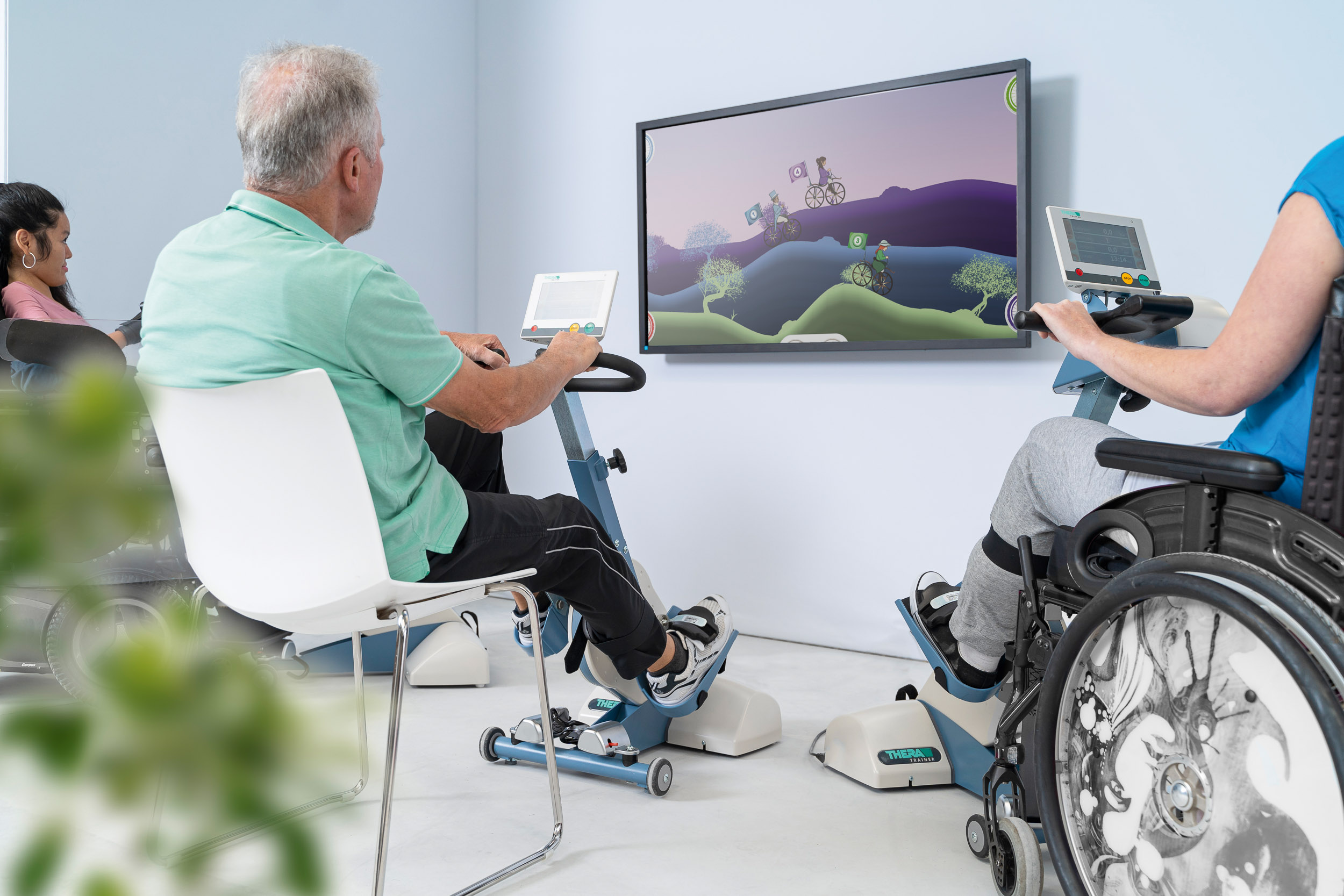
Cycling improves walking performance after a stroke
A 2023 review confirms that stationary cycling enhances walking speed and endurance in stroke patients. Learn how structured, moderate-to-intense aerobic training boosts recovery and complements gait rehabilitation.

Jakob Tiebel
Health Business Consultant
A recent review confirms the positive effects of stationary cyclical movement training on walking ability in stroke patients
Stationary cyclical movement training has been shown to be a safe and effective method of improving the cardiovascular health of stroke patients. Although it is not primarily used to restore the ability to walk, numerous studies have reported positive effects on walking parameters. In a recent review from 2023, Medeeha Khan and colleagues from the Cleveland Clinic investigated the effects of stationary cycling on walking ability in adults after stroke, finding significant improvements in walking speed and walking ability.
Stationary cyclical movement training is a safe and practicable method for implementing aerobic training to improve cardiovascular health in stroke patients. Although cyclical movement training is not typically used as a task-specific exercise approach to restore walking ability, numerous studies have reported improvements in walking parameters as a result of this type of training.
Stationary cyclical movement training is a safe and practicable method for implementing aerobic training to improve cardiovascular health in stroke patients. Although cyclical movement training is not typically used as a task-specific exercise approach to restore walking ability, numerous studies have reported improvements in walking parameters as a result of this type of training.
Objectivel
In a recent literature review from 2023, Medeeha Khan and colleagues from the Department of Physical Medicine and Rehabilitation at the Cleveland Clinic in the USA investigated the effects of stationary cycling on walking ability in adults after a stroke.
In a recent literature review from 2023, Medeeha Khan and colleagues from the Department of Physical Medicine and Rehabilitation at the Cleveland Clinic in the USA investigated the effects of stationary cycling on walking ability in adults after a stroke.
The current review from 2023 confirms that stationary cycling achieves significant improvements in walking performance in stroke patients.
Methods
As part of a systematic literature search, the researchers searched relevant databases and registers for studies on the use of movement training in stroke patients. Where gait parameter results were reported in the studies, these were extracted to determine the relationship between the training protocol parameters and changes in gait parameters using calculated correlation coefficients.
As part of a systematic literature search, the researchers searched relevant databases and registers for studies on the use of movement training in stroke patients. Where gait parameter results were reported in the studies, these were extracted to determine the relationship between the training protocol parameters and changes in gait parameters using calculated correlation coefficients.
Particularly in the early phase of rehabilitation and to increase the therapy dose, structured movement training should be an integral part of every rehabilitation routine.

Results
A total of 11 articles were included in the analyses. Eight studies representing nine movement training intervention groups reported changes in walking ability, as measured by the six-minute walk test, with improvements ranging from 6.1 to 63.0 metres. Seven studies measured walking speed and reported improvements in the range of 0.01 to 0.21 m/s. Protocols that achieved the greatest improvements in walking ability prescribed aerobic exercise of moderate to high intensity. Significant positive correlations were measured between the change in walking speed and the number of training sessions as well as the total number of training minutes prescribed.
A total of 11 articles were included in the analyses. Eight studies representing nine movement training intervention groups reported changes in walking ability, as measured by the six-minute walk test, with improvements ranging from 6.1 to 63.0 metres. Seven studies measured walking speed and reported improvements in the range of 0.01 to 0.21 m/s. Protocols that achieved the greatest improvements in walking ability prescribed aerobic exercise of moderate to high intensity. Significant positive correlations were measured between the change in walking speed and the number of training sessions as well as the total number of training minutes prescribed.
Conclusion
The researchers report that there is considerable heterogeneity in the study protocols in terms of intensity, frequency, training duration and protocol duration. However, none of the studies reported any deterioration in walking ability, and improvements were demonstrated even without the use of specific gait training. Exercise interventions that included moderate to intense aerobic exercise and 24 or more sessions showed the greatest effects in improving walking ability and walking speed.
The researchers report that there is considerable heterogeneity in the study protocols in terms of intensity, frequency, training duration and protocol duration. However, none of the studies reported any deterioration in walking ability, and improvements were demonstrated even without the use of specific gait training. Exercise interventions that included moderate to intense aerobic exercise and 24 or more sessions showed the greatest effects in improving walking ability and walking speed.
Taking into account the current evidence on gait therapy, the results confirm that cyclical movement training is strongly recommended as a complementary therapy.
Comments
This review supports the results of previous studies and shows that stationary cyclical movement training can significantly improve walking ability and walking speed in stroke patients. By repeatedly practising cyclical movements, specific muscle groups are trained and neuromuscular connections that are essential for walking are strengthened.
Previous studies have also shown that cyclical movement training can lead to activation of the central pattern generators (CPG) at spinal cord level. The researchers’ correlation analyses confirm that both the duration and the intensity of the training are decisive for the success of the treatment. In particular, studies that included moderate to intensive aerobic training with more than 24 sessions achieved the best results. Despite the heterogeneity of the protocols studied, no deterioration occurred even during intensive training, which emphasises the effectiveness and safety of cycling in stroke rehabilitation. Structured, progressive cyclical movement training cannot and should not replace intensive, task-specific gait training in stroke rehabilitation, although transfer effects have been demonstrated even without specific gait training.
Taking into account the current evidence on gait therapy, the results confirm that cyclical movement training is strongly recommended as a complementary therapy. Particularly in the early phase of rehabilitation and to increase the therapy dose, structured movement training should be an integral part of every rehabilitation routine.
This review supports the results of previous studies and shows that stationary cyclical movement training can significantly improve walking ability and walking speed in stroke patients. By repeatedly practising cyclical movements, specific muscle groups are trained and neuromuscular connections that are essential for walking are strengthened.
Previous studies have also shown that cyclical movement training can lead to activation of the central pattern generators (CPG) at spinal cord level. The researchers’ correlation analyses confirm that both the duration and the intensity of the training are decisive for the success of the treatment. In particular, studies that included moderate to intensive aerobic training with more than 24 sessions achieved the best results. Despite the heterogeneity of the protocols studied, no deterioration occurred even during intensive training, which emphasises the effectiveness and safety of cycling in stroke rehabilitation. Structured, progressive cyclical movement training cannot and should not replace intensive, task-specific gait training in stroke rehabilitation, although transfer effects have been demonstrated even without specific gait training.
Taking into account the current evidence on gait therapy, the results confirm that cyclical movement training is strongly recommended as a complementary therapy. Particularly in the early phase of rehabilitation and to increase the therapy dose, structured movement training should be an integral part of every rehabilitation routine.
Cycling
Fachkreise
Produkte
Science
Stationäre Rehabilitation
THERAPY 2024-II
THERAPY Magazine

Jakob Tiebel
Health Business Consultant
Jakob Tiebel is OT and studied applied psychology with a focus on health economics. He has clinical expertise from his previous therapeutic work in neurorehabilitation. He conducts research and publishes on the theory-practice transfer in neurorehabilitation and is the owner of an agency for digital health marketing.
References:
- Khan M, Maag LM, Harnegie MP, Linder SM. The effects of cycling on walking outcomes in adults with stroke: a systematic review. Top Stroke Rehabil. 2024 Apr;31(3):259-271. doi: 10.1080/ 10749357.2023.2259167. Epub 2023 Sep 21. PMID: 37732513.